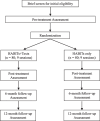Integrating habit science and learning theory to promote maintenance of behavior change: does adding text messages to a habit-based sleep health intervention (HABITs) improve outcomes for eveningness chronotype young adults? Study protocol for a randomized controlled trial
- PMID: 39563407
- PMCID: PMC11577865
- DOI: 10.1186/s13063-024-08599-4
Integrating habit science and learning theory to promote maintenance of behavior change: does adding text messages to a habit-based sleep health intervention (HABITs) improve outcomes for eveningness chronotype young adults? Study protocol for a randomized controlled trial
Abstract
Background: Eveningness chronotype-the tendency for later sleep and wake times-arises from a confluence of psychosocial, behavioral, and biological factors. With the onset and progression of puberty, many young people develop an eveningness chronotype, which remains prevalent through the transition into adulthood. Eveningness has been associated with increased risk for poorer health. While eveningness is modifiable, maintaining the necessary behavior changes can be challenging. The science on habits demonstrates that habit formation is a key mechanism for maintaining behavior change over time. Learning theory offers schedules of reinforcement that also hold promise for enhancing the maintenance of behavior change. The present study will evaluate the Habit-based Sleep Health Intervention (HABITs)-which combines the Transdiagnostic Intervention for Sleep and Circadian Dysfunction (TranS-C) with the science of habits-and a text message intervention informed by learning theory to attempt to sustainably modify the contributors to eveningness among young adults (18-30 years of age).
Methods: Participants (N = 160) will be randomly allocated to HABITs and HABITs + Texts. Both interventions include HABITs which involves three 50-min sessions followed by six 30-min sessions. Alongside the latter six sessions, HABITs + Texts will concurrently receive the text message intervention. Aims 1-3 will compare HABITs + Texts to HABITs on improvements in the outcomes of (1) utilization of sleep health behaviors and habit formation, (2) sleep and circadian functioning, and (3) functioning in five health-relevant domains, in the short (post-treatment) and longer (6-month and 12-month follow-up) term. Exploratory analysis will (1) compare HABITs and HABITs + Texts on (a) if sleep health behavior habit formation mediates the effects of intervention on improvement in outcomes and (b) if intervention effects are moderated by select variables, and (2) to evaluate if HABITs (regardless of the text message intervention) is associated with an improvement in outcomes in the short and longer term.
Discussion: This study has the potential to advance knowledge on (1) the value of leveraging the science of habits and learning theory in behavior change interventions, (2) the use of a low-cost and efficient intervention for habit formation and maintenance, (3) interventions that address eveningness chronotype, and (4) processes related to behavior change during emerging adulthood.
Trial registration: Clinicaltrials.gov NCT05167695. Registered on December 22, 2021.
Keywords: Circadian; Habits; Health; Intervention; Sleep; Text message; Transdiagnostic.
© 2024. The Author(s).
Conflict of interest statement
Similar articles
-
Transdiagnostic Sleep and Circadian Intervention for Adolescents Plus Text Messaging: Randomized Controlled Trial 12-month Follow-up.J Clin Child Adolesc Psychol. 2023 Nov-Dec;52(6):750-762. doi: 10.1080/15374416.2021.1978295. Epub 2021 Dec 22. J Clin Child Adolesc Psychol. 2023. PMID: 34936528 Free PMC article. Clinical Trial.
-
Integrating the Memory Support Intervention into the Transdiagnostic Intervention for Sleep and Circadian Dysfunction (TranS-C): can improving memory for treatment in midlife and older adults improve patient outcomes? Study protocol for a randomized controlled trial.Trials. 2024 Oct 3;25(1):650. doi: 10.1186/s13063-024-08468-0. Trials. 2024. PMID: 39363383 Free PMC article.
-
Effects of cognitive behavioural therapy and bright light therapy for insomnia in youths with eveningness: study protocol for a randomised controlled trial.Trials. 2024 Apr 9;25(1):246. doi: 10.1186/s13063-024-08090-0. Trials. 2024. PMID: 38594725 Free PMC article.
-
Intervention to Modify Habits: A Scoping Review.OTJR (Thorofare N J). 2020 Apr;40(2):99-112. doi: 10.1177/1539449219876877. Epub 2019 Oct 23. OTJR (Thorofare N J). 2020. PMID: 31642394
-
Chronotype-related differences in childhood and adolescent aggression and antisocial behavior--a review of the literature.Chronobiol Int. 2014 Feb;31(1):1-16. doi: 10.3109/07420528.2013.829846. Epub 2013 Oct 22. Chronobiol Int. 2014. PMID: 24147657 Review.
References
-
- Adan A, Archer SN, Hidalgo MP, Di Milia L, Natale V, Randler C. Circadian Typology: A Comprehensive Review. Chronobiol Int. 2012Nov;29(9):1153–75. - PubMed
-
- Horne JA, Östberg O. Individual differences in human circadian rhythms. Biol Psychol. 1977Sep;5(3):179–90. - PubMed
-
- Gau SSF, Shang CY, Merikangas KR, Chiu YN, Soong WT, Cheng ATA. Association between Morningness-Eveningness and Behavioral/Emotional Problems among Adolescents. J Biol Rhythms. 2007Jun;22(3):268–74. - PubMed
Publication types
MeSH terms
Associated data
Grants and funding
LinkOut - more resources
Full Text Sources
Medical


